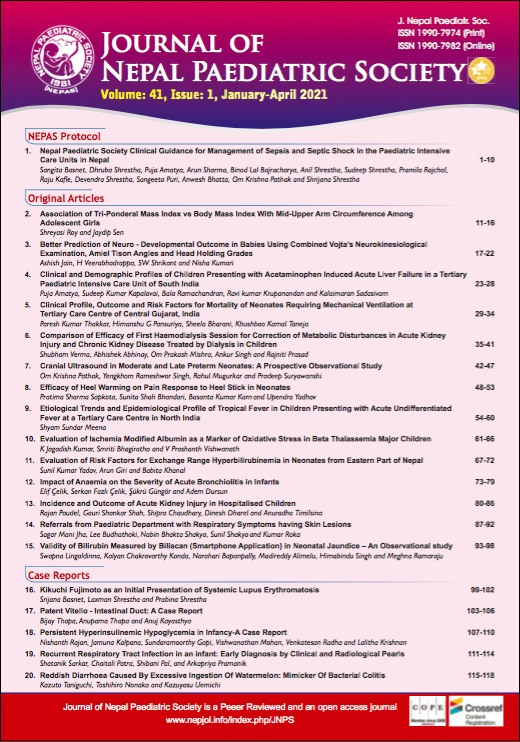Better Prediction of Neuro - Developmental Outcome in Babies Using Combined Vojta’s Neurokinesiological Examination, Amiel Tison Angles and Head Holding Grades
DOI:
https://doi.org/10.3126/jnps.v41i1.29993Keywords:
Amiel-Tison angles, High risk babies, Trivendrum development screening chart, Vojta's neurokinesiologicalAbstract
Introduction: With the advances in medical technology, the survival rate has increased amongst the high-risk neonates. Changes occurring in the neuro-motor function during the first year of life are closely related to the maturation of the central nervous system of babies and the presence or absence of injury to brain. These should be detected as early as possible, so that intervention programmes can be started.
Methods: A prospective study was done in NICU of a teaching hospital, to find the predictive value of combined assessment by three neuro-developmental examinations Viz. Vojta’s Neurokinesiological examination, Amiel-Tison angles and head holding grades. Total 375 babies with various high risk category were included, out of which only 114 infants completed one-year follow-up. On the first visit a detailed neurological examination was performed using Vojtas Neurokinesological postures, Amiel- Tison angles and head holding grades based on Trivandrum Developmental Screening Chart (TDSC). At one year, the milestones attained were plotted against the BSID percentiles and babies assigned as developmentally delayed, if it was below 97% pass level. Sensitivity and specificity were calculated and propositions evaluated by chi-square test.
Results: 23% babies had developmental delay at one year. The important high risk factors were maternal risk factors 39%, HIE with MAS, HIE stage-III, complications during NICU stay.
Conclusions: Vojta’s Neurokinesiological examination is an effective screening test that can be applied to all high-risk neonates. The predictive value could be enhanced to 100%, by using other simple tests, like Amiel-Tison Angles and Head holding grades by TDSC.
Downloads
Downloads
Published
How to Cite
Issue
Section
License
Authors who publish with this journal agree to the following terms:
Authors retain copyright and grant the journal right of first publication with the work simultaneously licensed under a Creative Commons Attribution License that allows others to share the work with an acknowledgement of the work's authorship and initial publication in this journal.
Authors are able to enter into separate, additional contractual arrangements for the non-exclusive distribution of the journal's published version of the work (e.g., post it to an institutional repository or publish it in a book), with an acknowledgement of its initial publication in this journal.
Authors are permitted and encouraged to post their work online (e.g., in institutional repositories or on their website) prior to and during the submission process, as it can lead to productive exchanges, as well as earlier and greater citation of published work (See The Effect of Open Access).



